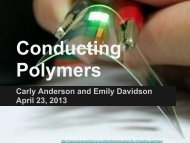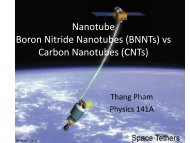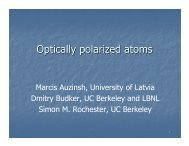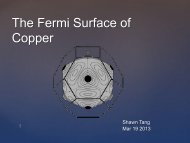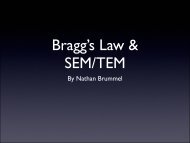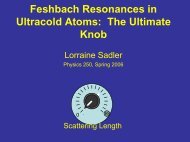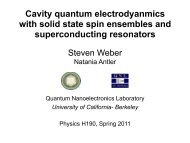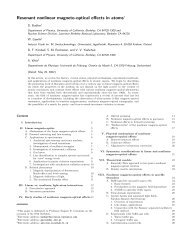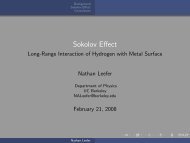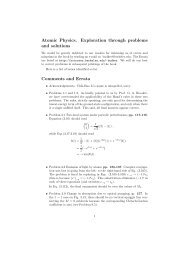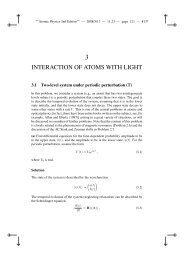Atomic Tests of Discrete Symmetries at Berkeley - The Budker Group
Atomic Tests of Discrete Symmetries at Berkeley - The Budker Group
Atomic Tests of Discrete Symmetries at Berkeley - The Budker Group
You also want an ePaper? Increase the reach of your titles
YUMPU automatically turns print PDFs into web optimized ePapers that Google loves.
SPECTROSCOPY AND POSSIBLE TESTS OF P,T-VIOLATION IN<br />
SAMARIUM<br />
<strong>The</strong>re are several parameters <strong>of</strong> importance in judging the merits <strong>of</strong> a system in which<br />
an EDM is measured. In addition to the large enhancement factor, it is also necessary<br />
to have a long spin-relax<strong>at</strong>ion time (a parameter th<strong>at</strong> enters directly into sensitivity to<br />
an EDM). Correspondingly, the majority <strong>of</strong> studies so far have been performed in <strong>at</strong>oms<br />
or molecules in their ground electronic st<strong>at</strong>es (e.g. [29]). <strong>The</strong> use <strong>of</strong> excited metastable<br />
st<strong>at</strong>es (as pioneered by Player and Sandars in 1970 [30]) may <strong>of</strong>fer significant advantages,<br />
including the possibility to access the potential enhancement afforded by level<br />
degeneracy. <strong>The</strong> development <strong>of</strong> this idea for molecules is discussed in a contribution<br />
by D. P. DeMille et. al. in these Proceedings.<br />
Another potentially useful system for an EDM experiment with metastable st<strong>at</strong>es<br />
is <strong>at</strong>omic samarium (Sm; Z = 62). In order to evalu<strong>at</strong>e the feasibility and merit <strong>of</strong> an<br />
EDM search in samarium, an experimental study was undertaken, the results <strong>of</strong> which<br />
were reported in Ref. [31]. A system<strong>at</strong>ic measurement <strong>of</strong> the lifetimes and tensor polarizabilities<br />
<strong>of</strong> the lowest-lying odd-parity levels was performed. <strong>The</strong> lifetimes were<br />
measured by detecting time-resolved fluorescence following pulsed laser excit<strong>at</strong>ion <strong>of</strong><br />
<strong>at</strong>oms in an <strong>at</strong>omic beam; polarizabilities were measured employing the method <strong>of</strong><br />
Stark-induced quantum be<strong>at</strong>s. An analysis <strong>of</strong> the d<strong>at</strong>a was undertaken to find the best<br />
even-parity candid<strong>at</strong>e st<strong>at</strong>es for an EDM measurement. For the most favorable candid<strong>at</strong>e<br />
st<strong>at</strong>e (nominally 4 f 6 5d6s 7 G 1 <strong>at</strong> 15639.80 cm −1 which has an opposite-parity “partner"<br />
st<strong>at</strong>e only ∼ 11 cm −1 away), the electron EDM enhancement factor was estim<strong>at</strong>ed to<br />
be R = ±1100 ± 800 ± (1300 to 1900). Here the three factors come from the contributions<br />
<strong>of</strong> various constituent electronic configur<strong>at</strong>ions and terms <strong>of</strong> the nearly degener<strong>at</strong>e<br />
st<strong>at</strong>es. Unfortun<strong>at</strong>ely, rel<strong>at</strong>ive signs in the configur<strong>at</strong>ion and term decomposition, although<br />
they must have been known to the workers whose analysis contributed to the<br />
compil<strong>at</strong>ion [32], have been apparently lost. This considerable remaining uncertainty in<br />
the enhancement factor has put further work on the EDM search in Sm on hold pending<br />
further theoretical or experimental input regarding the sign ambiguity. If it turns out th<strong>at</strong><br />
the terms in the enhancement factor are <strong>of</strong> the same sign, the enhancement factor could<br />
exceed th<strong>at</strong> <strong>of</strong> Tl by as much as an order <strong>of</strong> magnitude.<br />
<strong>The</strong> spectroscopic investig<strong>at</strong>ions in Sm [31] also led to a somewh<strong>at</strong> unexpected<br />
additional result. Critical analysis <strong>of</strong> the obtained lifetime and polarizability d<strong>at</strong>a along<br />
with earlier results in Sm showed quite unambiguously th<strong>at</strong> terms were incorrectly<br />
listed in [32] for a class <strong>of</strong> odd-parity st<strong>at</strong>es. <strong>The</strong> term reassignment cleared some longstanding<br />
discrepancies between theory and spectroscopic d<strong>at</strong>a in Sm. It also allowed to<br />
revise (namely, reduce by a factor <strong>of</strong> about 40) an estim<strong>at</strong>e <strong>of</strong> the PNC amplitude in a<br />
transition from the ground st<strong>at</strong>e <strong>of</strong> Sm to the 7 G 1 st<strong>at</strong>e originally made by the Oxford<br />
group [7] (see also Ref. [33] where experimental possibilities <strong>of</strong> measuring PNC in this<br />
transition were investig<strong>at</strong>ed). Our revised estim<strong>at</strong>e showed th<strong>at</strong> while the PNC amplitude<br />
in this Sm transition is still much larger than in Cs, it is probably somewh<strong>at</strong> smaller than<br />
th<strong>at</strong> in Yb (see above), and no obvious advantages <strong>of</strong> Sm were found.



